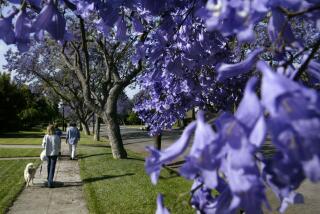Trade in rare plants sows trouble for endangered species
- Share via
Rare plants are increasingly finding their way outside their normal habitats because of commercial sellers and citizen conservationists, two ecologists warn. Unless the movement of such plants is better regulated, it could spell trouble for endangered species as well as the environments to which they are moved.
The caution, written by Patrick Shirey and Gary Lamberti at the University of Notre Dame and published in the journal Nature, warned that rare plants grown outside their native territories can disrupt their new environment, hybridize with related plants and blur their genetic individuality, or carry pathogens them that devastate other plants. They called for more uniform and rigorous regulation of Internet trade in rare plants across the U.S.
The scientists noted that about 10% of the 753 plants federally listed as threatened or endangered are being advertised for sale online.
Though increasing the numbers of rare plants may on the face of it seem helpful, ecological disasters can occur, Shirey said. He cited the case of the Australian paperbark tree, whose coastal habitats are threatened. That same tree, imported into the U.S. in the early 1900s, is considered a noxious weed in the United States and has caused millions of dollars of damage in the Florida Everglades.
Shirey worries about Brighamia insignis, known commonly as alula, or cabbage on a stick. In its natural habitat in Hawaii, fewer than 10 individual plants remain because their natural pollinators appear to have gone extinct. The plants can be hand pollinated and cultivated and are available at online nursery websites for less than $30 a pop.
Shirey also pointed to the case of Tennessee coneflower, which is currently listed as an endangered species (although the U.S. Fish and Wildlife Service has proposed it be delisted). The Tennessee coneflower hybridizes easily with other coneflower species, and in 2003 a commercial grower introduced a cross to the market. Having a hybrid available to purchase could reduce the threat of poaching. But, Shirey said, if these hybrids entered the native habitat they could compete for resources and hybridize in turn with the Tennessee coneflower.
Shirey noted that there is already a population of hybrid coneflowers growing near the home of the Tennessee coneflower.
Other groups are planting rare plants far from home with altruism in mind, not profit. Shirey cited as an example the Torreya Guardians, a loose-knit group of citizen and professional conservationists who are replanting the Florida torreya, a type of evergreen tree, on private land outside its current natural habitat. The conservationists justify this action by pointing out that the torreya used to thrive farther north in the last warm period between glacial freezes.
“It’s not in its correct habitat right now. It should be in the Appalachians,” said group cofounder Connie Barlow.
Citizen conservationists certainly have a part to play in saving rare plants, Shirey and Lamberti said. However, they added, a better approach would be to let federal officials take the lead and coordinate with citizen advocacy groups eager to help.
“Of all the possible impacts of exotic species on the native species and communities, I think the possibility of bringing in a pathogen or pest is probably the greatest,” said biologist Dan Simberloff, cofounder of the Institute for Biological Invasions biologist at the University of Tennessee, Knoxville, who was not involved in the study.







